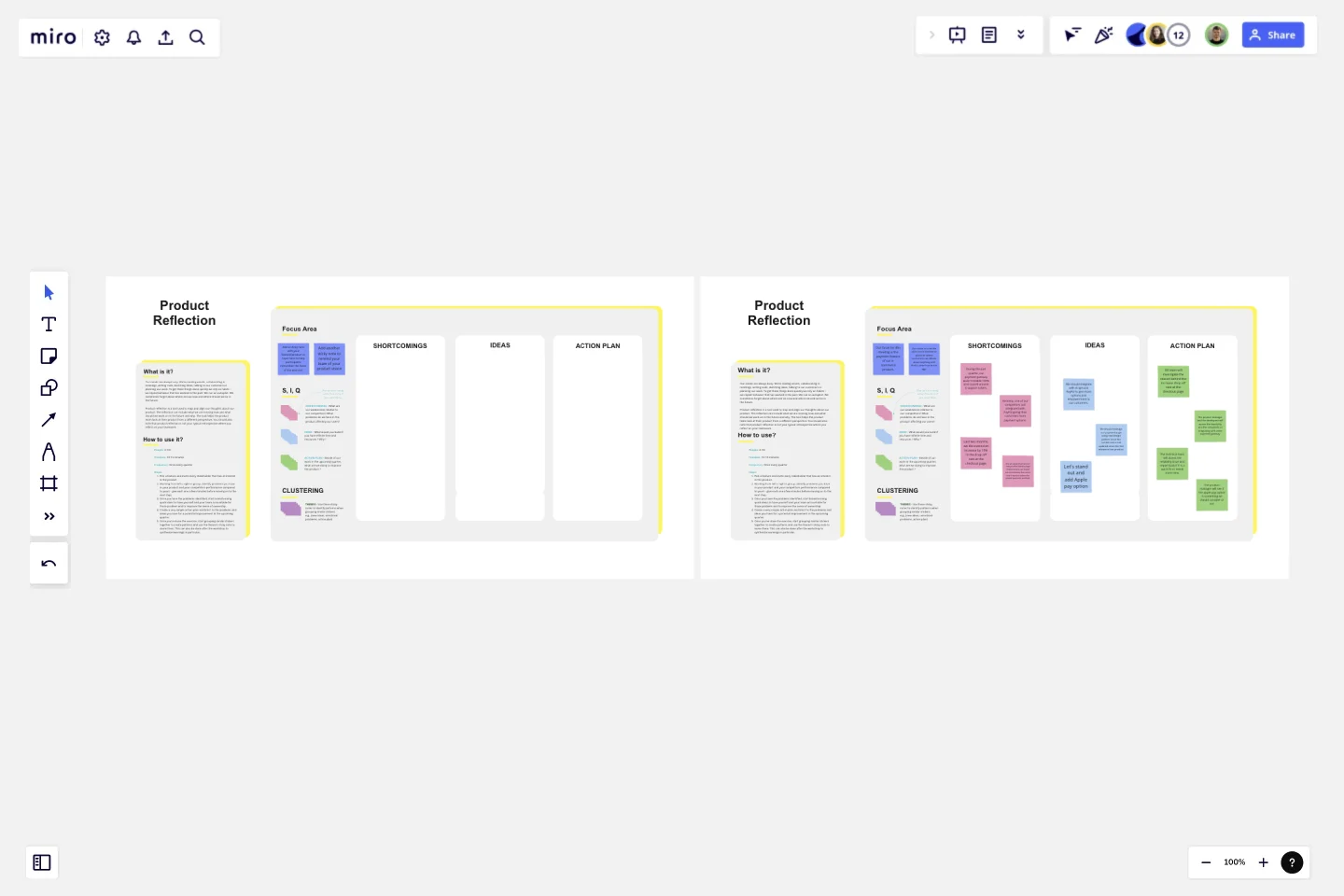Product Reflection
Before moving forward to the next quarter, the product team should step back and reflect on their product. The reflection they make on their product will help establish a better sense of ownership and generate more ideas as they go.
Trusted by 65M+ users and leading companies
About This Exercise
This template will help you gather your team to think collectively about the product for 3 perspectives, the current state, the future state, and what to do to achive the future outcome.
How To Use This Template ?
1) Every end of a quarter, pick a feature and invite every stakeholder that has an interest in the product.
2) Working from left o right in group, identify problems you have in your product and your competitors performance compared to yours - give each one a few minutes before moving on to the next step;
3) Once you have the problems identified, start brainstorming quick ideas to have yourself and your team accountable for those problem and to improve the sense of ownership.
4) Create a very simple action plan and link it to the problems and ideas you have for a potential improvement in the upcoming quarter.
5) Once you've done the exercise, start grouping similar stickers together to create patterns and use the theme's sticky note to name them. This can also be done after the workshop to synthesize learnings in particular.
This template was created by Shehab Beram.
Get started with this template right now.
Technology Roadmap Template
Works best for:
Agile Methodology, Roadmaps, Agile Workflows
A technology roadmap helps teams document the rationale of when, why, how, and what tech-related solutions can help the company move forward. Also known as IT roadmaps, technology roadmaps show teams what technology is available to them, focusing on to-be-scheduled improvements. They allow you to identify gaps or overlap between phased-out tech tools, as well as software or programs soon to be installed. From a practical point of view, the roadmap should also outline what kinds of tools are best to spend money on, and the most effective way to introduce new systems and processes.
Product Management - Product Flow
Works best for:
Product Management, Planning
Product Management - Product Flow template enables product managers to visualize and streamline product development processes. By mapping out key stages, tasks, and dependencies, this template enhances workflow transparency and coordination. With features for identifying bottlenecks and optimizing resource allocation, it empowers teams to improve efficiency and accelerate product delivery. This template serves as a valuable tool for ensuring smooth product development and launch processes, ultimately driving better outcomes.
B2B – Product Journey Map & User Network
Works best for:
Planning, Product Management
The B2B Product Journey Map & User Network template helps product teams visualize and understand the complex journey of B2B customers. By mapping user interactions, pain points, and touchpoints across the buyer's journey, this template provides insights into user behavior and preferences. With sections for analyzing user needs, identifying opportunities, and optimizing user experiences, it enables teams to design tailored solutions and drive customer satisfaction. This template serves as a strategic tool for enhancing B2B product offerings and maximizing customer value.
Empathy Map Template
Works best for:
Market Research, User Experience, Mapping
Attracting new users, compelling them to try your product, and turning them into loyal customers—it all starts with understanding them. An empathy map is a tool that leads to that understanding, by giving you space to articulate everything you know about your customers, including their needs, expectations, and decision-making drivers. That way you’ll be able to challenge your assumptions and identify the gaps in your knowledge. Our template lets you easily create an empathy map divided into four key squares—what your customers Say, Think, Do, and Feel.
Value Stream Mapping Template
Works best for:
Project Management, Strategic Planning, Mapping
A value stream map can help you refocus your business on steps that actually provide value to your customers, cutting out wasteful and inefficient processes. With this template, you and your process team can collaborate on a value stream map today.
Recruitment Strategy Roadmap
Works best for:
Roadmap, Planning, Mapping
The Recruitment Strategy Roadmap template helps organizations plan and execute their talent acquisition initiatives effectively. It provides a structured framework for identifying hiring needs, sourcing candidates, and evaluating recruitment channels. By aligning recruitment efforts with business objectives, organizations can attract and retain top talent, driving organizational growth and success.
